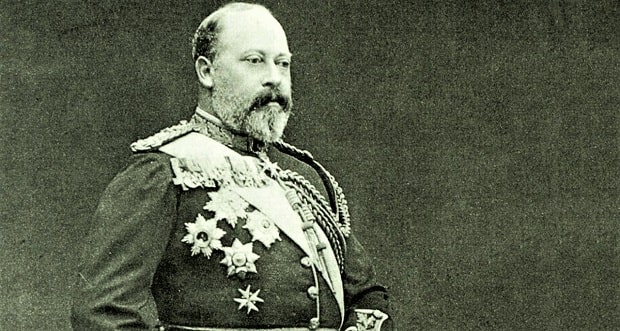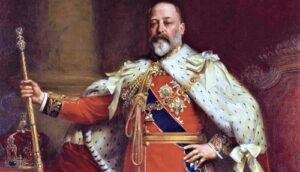
Edward VII (born Albert Edward on November 9, 1841, in London at Buckingham Palace and died on May 6, 1910, in the same place), is the king of the United Kingdom and the dominions (Canada, Australia, New Zealand, Newfoundland) as well as emperor of India from January 22, 1901, until his death.
Son of Queen Victoria, Albert-Edward remained the heir to the British Crown and carried the title of Prince of Wales for almost 60 years. During his mother’s long reign, he was largely sidelined from political issues and personified the wealthy British aristocratic elite.
The Edwardian era coincided with the beginning of the 20th century and underwent major technological and social changes. Edward VII played an important role in the modernization of the Home Fleet, the reform of military medical services, and the reorganization of the British Army after the Second Boer War
He developed good relations between the United Kingdom and the other European countries, in particular France, and for that received the popular nickname of Peacemaker.
Quick Facts: Edward VII
- Born: 9 November 1841, Buckingham Palace, London, United Kingdom
- Also known As: Albert Edward
- Known For: The king of the United Kingdom and the dominions
- Successor: George V
- Predecessor: Queen Victoria
- Reign: 22 January 1901 – 6 May 1910
- Coronation: 9 August 1902
- Parents: Father – Prince Albert of Saxe-Coburg and Gotha, Mother – Queen Victoria of the United Kingdom
- House: Saxe-Coburg and Gotha
- Spouse: Alexandra of Denmark (m. 1863)
- Children: George V (1841–1910), Prince Albert Victor (1864–1892), Maud of Wales (1869–1938), Princess Victoria (1868–1935), Louise, Princess Royal (1867–1931), Alexander John
The Early Life of Edward VII
Prince Albert Edward was born on November 9, 1841, the eldest son of the ruling British Queen Victoria and her Prince Consort Albert of Saxe-Coburg and Gotha in London’s Buckingham Palace. He was awarded the title of Prince of Wales four weeks after his birth.
Victoria and Albert were determined to give Bertie, as he was called in the closer family, an education that would make him an exemplary constitutional monarch. His extremely strict father ordered private tutors and educators and handed them over to the seven-year-old prince, who was however inconsistent and did not prove to be a model student.
From summer 1859 he began to study; initially at Edinburgh University, where he was under the supervision of Professor Lyon Playfair. He then became a student at the venerable University of Oxford and moved to Cambridge at Trinity College in 1861, where he worked in history from the renowned professor Charles Kingsley was taught.

In the meantime, he assumed the first official duties for the royal family as heir to the throne and traveled to North America in 1860. A British heir to the throne visited Canada and the United States for the first time. Edward showed great diplomatic skills and the visit was celebrated as a foreign policy success.
During his studies, Edward shone less with performance than with his excessive lifestyle. The prince was a dandy with preferences for gambling, alcohol, and young actresses, whose love adventures remained no secret.
The result was that his already seriously ill father came to Cambridge in December 1861 to speak to Edward and to reprimand him. Prince consort Albert died two weeks later. Queen Victoria never got over the loss of her beloved husband and made “Bertie” responsible for his early death.
Marriage and Children of Edward VII
Queen Victoria was a dynastic thinking monarch and was concerned about the succession to the throne since Eduard was still single. She also wanted to steer her son’s life in an orderly fashion through marriage. With the help of her eldest daughter Princess Victoria, she arranged to marry Princess Alexandra of Denmark, the daughter of the future King Christian IX.
Edward VII and Alexandra married on March 10, 1863 in St George’s Chapel at Windsor Castle and Alexandra became Princess of Wales. The young couple moved into the city villa Marlborough House in London and a stately country house with Sandringham House in the county of Norfolk. A total of six children emerged from the connection:
- Albert Victor, Duke of Clarence and Avondale (born on January 8, 1864; Died on January 14, 1892)
- George, Duke of York, Prince of Wales (born on June 3, 1865, Died on January 20, 1936), as George V British King ⚭ Maria von Teck
- Louise, Princess Royal (born on February 20, 1867; Died on January 4, 1931) – Alexander Duff, 1st Duke of Fife
- Princess Victoria (born on July 6, 1868, Died on December 3, 1935)
- Maud (born on November 26, 1869, Died on November 20, 1938) – Haakon VII of Norway
- Alexander John (born on April 6, 1871, Died on April 7, 1871)
Prince of Wales
After her husband’s early death, Queen Victoria withdrew as far as possible from the public and lived a strict widowhood. For this reason, the crown prince had increased public appearances, which his mother avoided.
His cosmopolitan manner and diplomatic skills had a positive impact, especially when receiving foreign state guests. However, his mother did not allow him to play an active role in governance. Eduard was Prince of Wales for a total of 59 years and was considered an “heir to the throne.”
As a Prince of Wales, Edward was involved in two lawsuits. In 1870, in a divorce case, she was named to a society lady as the reason for divorce, and in 1891 in the Tranby Croft scandal, he was a witness in a lawsuit involving illegal gambling (baccarat). Despite all the misconduct and his way of life, Eduard enjoyed great popularity among the population.
Reign
When Queen Victoria died January 22, 1901, Albert became King of the United Kingdom and Empire of member countries with the status of dominions (Canada and Australia) and the emperor of India. He chose to reign under the name of Edward VII rather Albert Edward I wished his mother not to undervalue the name of Albert worn by his father and generally used only in the aristocracy.
The number ‘VII’ was not used in Scotland because the Scots protested against the other English monarchs bearing this name, all of whom had once been armed expelled from Scotland. Edward wanted to distance himself from his German descent, although he spoke English with a German accent until the end of his life.
Edward was crowned in Westminster Abbey on August 9, 1902, by Frederick Temple, Archbishop of Canterbury, who eighty years died just four months later. The coronation had been scheduled for June 26, but two days earlier the king was diagnosed with appendicitis.
The problem was not generally operable and had a high mortality rate, but developments in anesthesia and antiseptics in the previous fifty years have made surgery possible. Sir Frederick Treves, with the support of Joseph Lister, 1st Baron Lister, performed a radical operation for the time by draining the infected abscess through a small incision.
The next day, Edward was already sitting on his bed smoking his cigar. Two weeks later, it was announced that he was no longer in danger. Treves received a barony (which Edward had already prepared before the operation) and the surgery for appendicitis became famous.
Eduardo reformed the royal palaces, reintroducing traditional ceremonies, such as the Opening of Parliament, which his mother had renounced, also founding new honorary orders, such as the Order of Merit to recognize contributions in the fields of arts and sciences.
Emperor Mozaffar-al-Din of Persia visited England in 1902 hoping to receive the Order of the Garter. Edward VII refused to give such an honor because the order was supposed to be a personal gift from the monarch and Henry Petty-Fitzmaurice, 5th Marquess of Lansdowne, his Foreign Secretary, had promised to deliver the order without his consent.
Edward was also against introducing a Muslim into a Christian cavalry order. His refusal threatened to damage British attempts to gain influence in Persia, but the king resented his ministers’ attempts to diminish his traditional powers. Subsequently, he relented and the United Kingdom sent the following year a special embassy to the emperor with the complete Order of the Jarry.
End of Reign and Death
Edward VII usually smoked 40 cigarettes and cigars a day. Towards the end of his life, he suffered more and more from bronchitis. In March 1910, the king was in Biarritz when he collapsed. He stayed there some time to recover while in London Asquith was trying to pass the budget law.
The king’s ill health was kept secret and he was criticized for staying in France when political tensions were at its height. On April 27, he always returned suffering at Buckingham Palace. Alexandra returned from a visit to her brother George I of Greece in Corfu a week later, on May 5
The next day, the king suffered from several heart attacks but refused to go to bed declaring, No, I will not give up; I will continue; I will work until the end. The Prince of Wales tells him that his horse, Witch of the Air, won the Kempton Park race in the afternoon.
The king answered I am delighted and it was his last words because he lost consciousness for 23 h 30 and was put in bed; he died 15 minutes later. The king disappears after a short reign of only nine years, at the age of 68. His eldest son, the Prince of Wales, George, succeeded him on the throne at the age of 44.
On May 20, his coffin was taken to Westminster Hall before being buried in the chapel of St. George of Windsor Castle. In The Guns of August, Barbara W. Tuchman described her funeral in this way: never have so many of the great people of this land been together in this way, never again should they be in this form. Indeed, nine European sovereigns and a large number of nobles, many of whom were related to the deceased and gathered for this event.